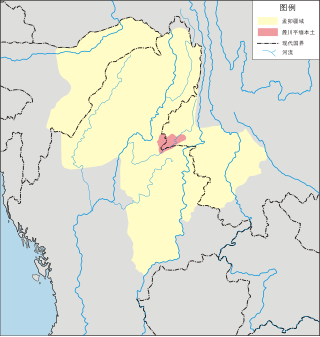Top Qs
Timeline
Chat
Perspective
Si Kefa
Ruler of Möng Mao From Wikipedia, the free encyclopedia
Remove ads
Si Kefa[a] (1296-1369), known as Hsö Hkan Hpa[b] in Tai and Thohanbwa in Burmese, was the ruler of Möng Mao from 1335 to 1369. He sacked the Burmese kingdoms of Sagaing and Pinya in 1364.[1][2]

Remove ads
Name
At birth, Si Kefa was named Sao Yi or Hkun Yi Kang Hkam, meaning "Second Lord" in Tai. On his coronation he obtained the name Hsö Hkan Hpa,[b] meaning "Tiger Clawed Lord", and Tai chronicles attribute its origin to the claw marks left on his back by a tiger.[3][4]
His name was translated into Chinese as Si Kefa,[a] and into Burmese as Thohanbwa.[c][3][5]
Rise to power
The exact date of Si Kefa's accession to the throne is unknown in Chinese records. In 1330, a native official of the Yuan dynasty was appointed to Luchuan Route (Möng Mao), but it's unclear if this official was Si Kefa. At the time, Luchuan was just one of many minor Tai polities in southwestern Yunnan. Luchuan was not mentioned again until 1342, by which point Si Kefa had already transformed his kingdom into the region's dominant power, and the Yuan were sending a punitive expedition against him.[6][7]
Tai chronicles are also unclear about the exact date of his accession, sometimes differing considerably from one chronicle to another. The most plausible date given is 1335, the year of his accession in a local chronicle of Möng Mao.[8]
Remove ads
Reign
Summarize
Perspective
In Tai chronicles, after gaining the throne Hsö Hkan Hpa first built a new capital at Selan (between Namhkam and Muse), fortifying it with strong walls and deep moats. He then gained the submission of neighbouring Tai states, including Hsenwi, Möng Mit and Küngma, and gathered a large army to march into Yunnan.[9]
The Yuan court ordered local Yunnan authorities to subdue him and four military expeditions were sent in 1342, 1346, 1347 and 1348, but they ended in failure. Fearing further attacks, Hsö Hkan Hpa sent his son, the heir apparent (mansan 滿三[d]), to the Yuan court to nominally recognize their authority. With the outbreak of the Red Turban Rebellions, there was little else the Yuan could do to subdue him, so he was appointed as the "Pingmian Pacification Commissioner", a title which recognized his control over new territories and further bolstered his prestige and legitimacy. [11][12]
After the war with China, Hsö Hkan Hpa turned his attention west. He sent his brother Hkun Sam Lông west to conquer Assam, which surrendered without resistance and began paying tribute. However, believing his brother was conspiring against him, he poisoned and killed him on his return.[13] The Sagaing kingdom sent an expedition against Möng Mao in 1356, possibly as a response to Möng Mao's expansion into Kale. Hsö Hkan Hpa then ordered expeditions against the Burmese kingdoms of Sagaing and Pinya. Shan raids were reported in 1359 and 1362, and finally the two kingdoms fell in 1364 and were completely devastated, leading to the rise of the Ava kingdom.[14][13]
Hsö Hkan Hpa died in 1369. He was succeeded by his eldest son Si Bingfa (called Hsö Pem Hpa in Tai).[15]
Both the Möng Mao and Hsenwi chronicles provide lists of the far-flung domains he is said to have controlled reaching to the border of the Kingdom of Dali in the north, Xishuangbanna to the south, Central Myanmar to the southwest, and Yongchang to the west.[16]
In the Burmese chronicles, he is remembered as the leader of the Maw forces that sacked the kingdoms of Sagaing and Pinya in 1364. He brought back King Narathu of Pinya and the loot to the Maw country. In the wake of the attacks, a Sagaing prince named Thado Minbya founded the Ava Kingdom in 1365.[17][18]
Si Kefa has a privileged position in Mong Mao chronicle history as defining "an age when the Tay [Tai] lived in an expansive independent kingdom ruled by their own kings and use it as a point of departure for their accounts of post-fifteenth century history"[16]
Remove ads
Notes
- Mansan 滿三 is a Chinese transliteration of the Tai term maang saa ᥛᥣᥒᥰ ᥘᥣᥰ, meaning prince or heir apparent, a Burmese loanword used frequently in Tai literature.[10]
Remove ads
References
Bibliography
Wikiwand - on
Seamless Wikipedia browsing. On steroids.
Remove ads
